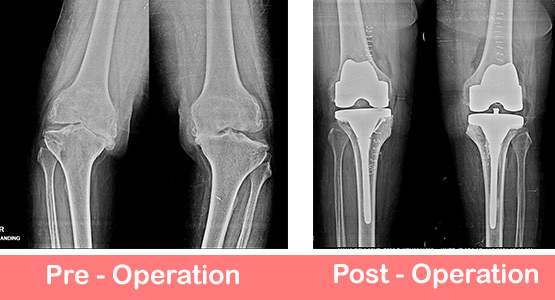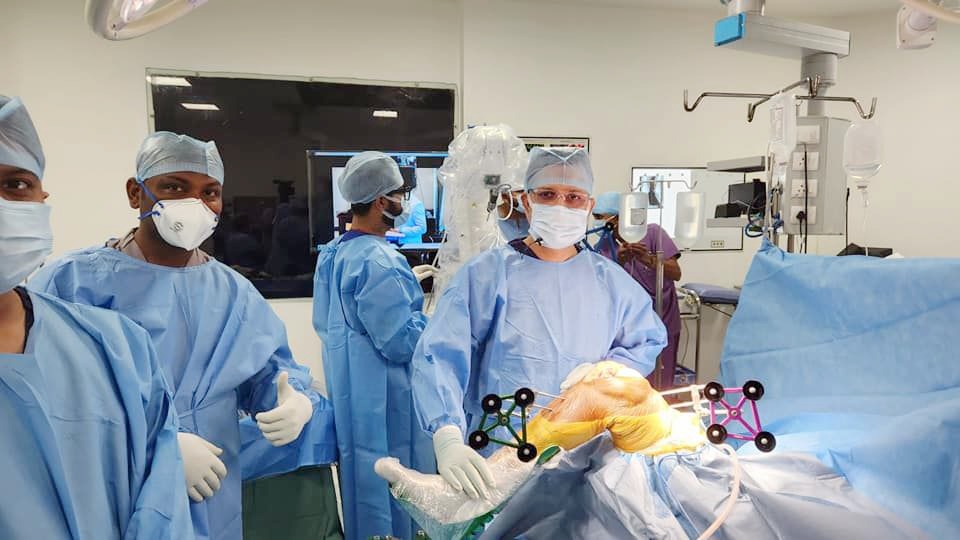

The knee joint is the largest and the most complex joint of the body. It provides us with support and mobility for movements of our daily living like walking, sitting, squatting, turning, running, driving, and dancing. Due to Arthritis, the knee joint becomes damaged leading to the knee becoming stiff and swollen. It is only then that we realize what freedom of movement means to us.

When a person is suffering from end stage arthritis which cannot be helped through oral medication, knee replacement surgery becomes the only option.
Total knee replacement is an operation in which we do not remove the whole joint, only the damaged surface of thigh bone (femur) and shin bone (tibia) are removed. Often, the underside of the knee cap (patella) is also removed and these surfaces are replaced with artificial parts. It is an operation where one is resurfacing the damaged knee joint, as is done in capping a damaged tooth.
Primary Total Knee Replacement Surgery: Unilateral / Bilateral same sitting.
Symptoms: Pain in knee, difficulty walking and climbing stairs, deformity in knees such as valgus deformity (knock knees) or varus deformity
(bow legs).
Primary Uni-Compartmental Knee Replacement Surgery: Unilateral / Bilateral same sitting.
Symptoms: Early stage arthritis causing damage to one part of the knee.
Patient Specific Instrument Knee Replacement Surgery:
This advanced technique allows customization of the operation specially designed for you and results in a more accurate fitting of the artificial joint. The operation becomes simpler and easier, the recovery is faster and the long-term success will undoubtedly be better.
Revision Knee Replacement Surgery:

Under the leadership of Dr. Shekhar Shrivastav, Delhi Institute of Trauma and Orthopaedics is one of the best hospitals in Delhi and pan India for joint replacement surgery which includes knee replacement, hip replacement, shoulder replacement and elbow replacement. Dr.Shekhar Shrivastav is also one of the only doctors who does complicated revision joint replacement surgery and is considered one of the best in the field. At Delhi Institute of Trauma & Orthopaedics, results for knee replacement surgery are the best in class.
When various therapies like physical therapy,medicines and injections fail to ease severe knee pain, a knee replacement operation is often advised. Osteoarthritis, a degenerative joint condition that affects millions of individuals worldwide, is the most frequent cause of knee replacement surgery. This ailment causes the cartilage in the knee joint to wear down over time, leading to pain, stiffness, and difficulty moving the knee.
During a knee replacement procedure, the damaged knee joint components are removed and swapped out for an artificial metal and plastic joint. Patients may move their knee more freely and painlessly because of this revolutionary joint, which is made to replicate the knee’s natural motion.
Knee replacement surgery has some hazards, just like any other medical operation.However, by selecting a qualified and experienced surgeon, carefully adhering to pre- and post-operative instructions, and attending all follow-up visits, these risks can be reduced.
Patients should refrain from specific activities while recovering after knee replacement surgery to reduce the risk of problems and accelerate healing. During the course of their rehab, patients should refrain from the following common activities:
For those with persistent knee discomfort, Knee Replacement Surgeon perform a routine operation that can considerably enhance quality of life. Although there are certain dangers associated with the operation, for the majority of individuals, the advantages outweigh the disadvantages. If you’re thinking about having a knee replacement, it’s essential to speak with a qualified orthopedic surgeon to find out if the procedure is correct for you and to create a personalized treatment plan.